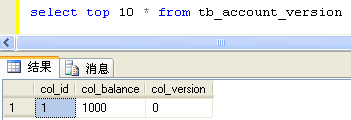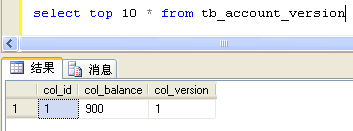Java的Hibernate框架数据库操作中锁的使用和查询类型
Hibernate与数据库锁
一、为什么要使用锁?
要想弄清楚锁机制存在的原因,首先要了解事务的概念。
事务是对数据库一系列相关的操作,它必须具备ACID特征:
A(原子性):要么全部成功,要么全部撤销。
C(一致性):要保持数据库的一致性。
I(隔离性):不同事务操作相同数据时,要有各自的数据空间。
D(持久性):一旦事务成功结束,它对数据库所做的更新必须永久保持。
我们常用的关系型数据库RDBMS实现了事务的这些特性。其中,原子性、
一致性和持久性都是采用日志来保证的。而隔离性就是由今天我们关注的
锁机制来实现的,这就是为什么我们需要锁机制。
如果没有锁,对隔离性不加控制,可能会造成哪些后果呢?
更新丢失:事务1提交的数据被事务2覆盖。
脏读:事务2查询到了事务1未提交的数据。
虚读:事务2查询到了事务1提交的新建数据。
不可重复读:事务2查询到了事务1提交的更新数据。
下面来看Hibernate的例子,两个线程分别开启两个事务操作tb_account表中
的同一行数据col_id=1。
package com.cdai.orm.hibernate.annotation;
import java.io.Serializable;
import javax.persistence.Column;
import javax.persistence.Entity;
import javax.persistence.Id;
import javax.persistence.Table;
@Entity
@Table(name = "tb_account")
public class Account implements Serializable {
private static final long serialVersionUID = 5018821760412231859L;
@Id
@Column(name = "col_id")
private long id;
@Column(name = "col_balance")
private long balance;
public Account() {
}
public Account(long id, long balance) {
this.id = id;
this.balance = balance;
}
public long getId() {
return id;
}
public void setId(long id) {
this.id = id;
}
public long getBalance() {
return balance;
}
public void setBalance(long balance) {
this.balance = balance;
}
@Override
public String toString() {
return "Account [id=" + id + ", balance=" + balance + "]";
}
}package com.cdai.orm.hibernate.transaction;
import org.hibernate.Session;
import org.hibernate.SessionFactory;
import org.hibernate.Transaction;
import org.hibernate.cfg.AnnotationConfiguration;
import com.cdai.orm.hibernate.annotation.Account;
public class DirtyRead {
public static void main(String[] args) {
final SessionFactory sessionFactory = new AnnotationConfiguration().
addFile("hibernate/hibernate.cfg.xml").
configure().
addPackage("com.cdai.orm.hibernate.annotation").
addAnnotatedClass(Account.class).
buildSessionFactory();
Thread t1 = new Thread() {
@Override
public void run() {
Session session1 = sessionFactory.openSession();
Transaction tx1 = null;
try {
tx1 = session1.beginTransaction();
System.out.println("T1 - Begin trasaction");
Thread.sleep(500);
Account account = (Account)
session1.get(Account.class, new Long(1));
System.out.println("T1 - balance=" + account.getBalance());
Thread.sleep(500);
account.setBalance(account.getBalance() + 100);
System.out.println("T1 - Change balance:" + account.getBalance());
tx1.commit();
System.out.println("T1 - Commit transaction");
Thread.sleep(500);
}
catch (Exception e) {
e.printStackTrace();
if (tx1 != null)
tx1.rollback();
}
finally {
session1.close();
}
}
};
// 3.Run transaction 2
Thread t2 = new Thread() {
@Override
public void run() {
Session session2 = sessionFactory.openSession();
Transaction tx2 = null;
try {
tx2 = session2.beginTransaction();
System.out.println("T2 - Begin trasaction");
Thread.sleep(500);
Account account = (Account)
session2.get(Account.class, new Long(1));
System.out.println("T2 - balance=" + account.getBalance());
Thread.sleep(500);
account.setBalance(account.getBalance() - 100);
System.out.println("T2 - Change balance:" + account.getBalance());
tx2.commit();
System.out.println("T2 - Commit transaction");
Thread.sleep(500);
}
catch (Exception e) {
e.printStackTrace();
if (tx2 != null)
tx2.rollback();
}
finally {
session2.close();
}
}
};
t1.start();
t2.start();
while (t1.isAlive() || t2.isAlive()) {
try {
Thread.sleep(2000L);
} catch (InterruptedException e) {
}
}
System.out.println("Both T1 and T2 are dead.");
sessionFactory.close();
}
}事务1将col_balance减小100,而事务2将其减少100,最终结果可能是0,也
可能是200,事务1或2的更新可能会丢失。log输出也印证了这一点,事务1和2
的log交叉打印。
T1 - Begin trasaction T2 - Begin trasaction Hibernate: select account0_.col_id as col1_0_0_, account0_.col_balance as col2_0_0_ from tb_account account0_ where account0_.col_id=? Hibernate: select account0_.col_id as col1_0_0_, account0_.col_balance as col2_0_0_ from tb_account account0_ where account0_.col_id=? T1 - balance=100 T2 - balance=100 T2 - Change balance:0 T1 - Change balance:200 Hibernate: update tb_account set col_balance=? where col_id=? Hibernate: update tb_account set col_balance=? where col_id=? T1 - Commit transaction T2 - Commit transaction Both T1 and T2 are dead.
由此可见,隔离性是一个需要慎重考虑的问题,理解锁很有必要。
二、有多少种锁?
常见的有共享锁、更新锁和独占锁。
1.共享锁:用于读数据操作,允许其他事务同时读取。当事务执行select语句时,
数据库自动为事务分配一把共享锁来锁定读取的数据。
2.独占锁:用于修改数据,其他事务不能读取也不能修改。当事务执行insert、
update和delete时,数据库会自动分配。
3.更新锁:用于避免更新操作时共享锁造成的死锁,比如事务1和2同时持有
共享锁并等待获得独占锁。当执行update时,事务先获得更新锁,然后将
更新锁升级成独占锁,这样就避免了死锁。
此外,这些锁都可以施加到数据库中不同的对象上,即这些锁可以有不同的粒度。
如数据库级锁、表级锁、页面级锁、键级锁和行级锁。
所以锁是有很多种的,这么多锁要想完全掌握灵活使用太难了,我们又不是DBA。
怎么办?还好,锁机制对于我们一般用户来说是透明的,数据库会自动添加合适的
锁,并在适当的时机自动升级、降级各种锁,真是太周到了!我们只需要做的就是
学会根据不同的业务需求,设置好隔离级别就可以了。
三、怎样设置隔离级别?
一般来说,数据库系统会提供四种事务隔离级别供用户选择:
1.Serializable(串行化):当两个事务同时操纵相同数据时,事务2只能停下来等。
2.Repeatable Read(可重复读):事务1能看到事务2新插入的数据,不能看到对
已有数据的更新。
3.Read Commited(读已提交数据):事务1能看到事务2新插入和更新的数据。
4.Read Uncommited(读未提交数据):事务1能看到事务2没有提交的插入和更新
数据。
四、应用程序中的锁
当数据库采用Read Commited隔离级别时,可以在应用程序中采用悲观锁或乐观锁。
1.悲观锁:假定当前事务操作的数据肯定还会有其他事务访问,因此悲观地在应用
程序中显式指定采用独占锁来锁定数据资源。在MySQL、Oracle中支持以下形式:
select ... for update
显式地让select采用独占锁锁定查询的记录,其他事务要查询、更新或删除这些被
锁定的数据,都要等到该事务结束后才行。
在Hibernate中,可以在load时传入LockMode.UPGRADE来采用悲观锁。修改前面的例子,
在事务1和2的get方法调用处,多传入一个LockMode参数。从log中可以看出,事务1和2
不再是交叉运行,事务2等待事务1结束后才可以读取数据,所以最终col_balance值是正确
的100。
package com.cdai.orm.hibernate.transaction;
import org.hibernate.LockMode;
import org.hibernate.Session;
import org.hibernate.SessionFactory;
import org.hibernate.Transaction;
import com.cdai.orm.hibernate.annotation.Account;
import com.cdai.orm.hibernate.annotation.AnnotationHibernate;
public class UpgradeLock {
@SuppressWarnings("deprecation")
public static void main(String[] args) {
final SessionFactory sessionFactory = AnnotationHibernate.createSessionFactory();
// Run transaction 1
Thread t1 = new Thread() {
@Override
public void run() {
Session session1 = sessionFactory.openSession();
Transaction tx1 = null;
try {
tx1 = session1.beginTransaction();
System.out.println("T1 - Begin trasaction");
Thread.sleep(500);
Account account = (Account)
session1.get(Account.class, new Long(1), LockMode.UPGRADE);
System.out.println("T1 - balance=" + account.getBalance());
Thread.sleep(500);
account.setBalance(account.getBalance() + 100);
System.out.println("T1 - Change balance:" + account.getBalance());
tx1.commit();
System.out.println("T1 - Commit transaction");
Thread.sleep(500);
}
catch (Exception e) {
e.printStackTrace();
if (tx1 != null)
tx1.rollback();
}
finally {
session1.close();
}
}
};
// Run transaction 2
Thread t2 = new Thread() {
@Override
public void run() {
Session session2 = sessionFactory.openSession();
Transaction tx2 = null;
try {
tx2 = session2.beginTransaction();
System.out.println("T2 - Begin trasaction");
Thread.sleep(500);
Account account = (Account)
session2.get(Account.class, new Long(1), LockMode.UPGRADE);
System.out.println("T2 - balance=" + account.getBalance());
Thread.sleep(500);
account.setBalance(account.getBalance() - 100);
System.out.println("T2 - Change balance:" + account.getBalance());
tx2.commit();
System.out.println("T2 - Commit transaction");
Thread.sleep(500);
}
catch (Exception e) {
e.printStackTrace();
if (tx2 != null)
tx2.rollback();
}
finally {
session2.close();
}
}
};
t1.start();
t2.start();
while (t1.isAlive() || t2.isAlive()) {
try {
Thread.sleep(2000L);
} catch (InterruptedException e) {
}
}
System.out.println("Both T1 and T2 are dead.");
sessionFactory.close();
}
}T1 - Begin trasaction T2 - Begin trasaction Hibernate: select account0_.col_id as col1_0_0_, account0_.col_balance as col2_0_0_ from tb_account account0_ with (updlock, rowlock) where account0_.col_id=? Hibernate: select account0_.col_id as col1_0_0_, account0_.col_balance as col2_0_0_ from tb_account account0_ with (updlock, rowlock) where account0_.col_id=? T2 - balance=100 T2 - Change balance:0 Hibernate: update tb_account set col_balance=? where col_id=? T2 - Commit transaction T1 - balance=0 T1 - Change balance:100 Hibernate: update tb_account set col_balance=? where col_id=? T1 - Commit transaction Both T1 and T2 are dead.
Hibernate对于SQLServer 2005会执行SQL:
select account0_.col_id as col1_0_0_, account0_.col_balance as col2_0_0_ from tb_account account0_ with (updlock, rowlock) where account0_.col_id=?
为选定的col_id为1的数据行加上行锁和更新锁。
2.乐观锁:假定当前事务操作的数据不会有其他事务同时访问,因此完全依靠数据库
的隔离级别来自动管理锁的工作。在应用程序中采用版本控制来避免可能低概率出现
的并发问题。
在Hibernate中,使用Version注解来定义版本号字段。

将DirtyLock中的Account对象替换成AccountVersion,其他代码不变,执行出现异常。
package com.cdai.orm.hibernate.transaction;
import javax.persistence.Column;
import javax.persistence.Entity;
import javax.persistence.Id;
import javax.persistence.Table;
import javax.persistence.Version;
@Entity
@Table(name = "tb_account_version")
public class AccountVersion {
@Id
@Column(name = "col_id")
private long id;
@Column(name = "col_balance")
private long balance;
@Version
@Column(name = "col_version")
private int version;
public AccountVersion() {
}
public AccountVersion(long id, long balance) {
this.id = id;
this.balance = balance;
}
public long getId() {
return id;
}
public void setId(long id) {
this.id = id;
}
public long getBalance() {
return balance;
}
public void setBalance(long balance) {
this.balance = balance;
}
public int getVersion() {
return version;
}
public void setVersion(int version) {
this.version = version;
}
}log如下:
T1 - Begin trasaction T2 - Begin trasaction Hibernate: select accountver0_.col_id as col1_0_0_, accountver0_.col_balance as col2_0_0_, accountver0_.col_version as col3_0_0_ from tb_account_version accountver0_ where accountver0_.col_id=? Hibernate: select accountver0_.col_id as col1_0_0_, accountver0_.col_balance as col2_0_0_, accountver0_.col_version as col3_0_0_ from tb_account_version accountver0_ where accountver0_.col_id=? T1 - balance=1000 T2 - balance=1000 T1 - Change balance:900 T2 - Change balance:1100 Hibernate: update tb_account_version set col_balance=?, col_version=? where col_id=? and col_version=? Hibernate: update tb_account_version set col_balance=?, col_version=? where col_id=? and col_version=? T1 - Commit transaction 2264 [Thread-2] ERROR org.hibernate.event.def.AbstractFlushingEventListener - Could not synchronize database state with session org.hibernate.StaleObjectStateException: Row was updated or deleted by another transaction (or unsaved-value mapping was incorrect): [com.cdai.orm.hibernate.transaction.AccountVersion#1] at org.hibernate.persister.entity.AbstractEntityPersister.check(AbstractEntityPersister.java:1934) at org.hibernate.persister.entity.AbstractEntityPersister.update(AbstractEntityPersister.java:2578) at org.hibernate.persister.entity.AbstractEntityPersister.updateOrInsert(AbstractEntityPersister.java:2478) at org.hibernate.persister.entity.AbstractEntityPersister.update(AbstractEntityPersister.java:2805) at org.hibernate.action.EntityUpdateAction.execute(EntityUpdateAction.java:114) at org.hibernate.engine.ActionQueue.execute(ActionQueue.java:268) at org.hibernate.engine.ActionQueue.executeActions(ActionQueue.java:260) at org.hibernate.engine.ActionQueue.executeActions(ActionQueue.java:180) at org.hibernate.event.def.AbstractFlushingEventListener.performExecutions(AbstractFlushingEventListener.java:321) at org.hibernate.event.def.DefaultFlushEventListener.onFlush(DefaultFlushEventListener.java:51) at org.hibernate.impl.SessionImpl.flush(SessionImpl.java:1206) at org.hibernate.impl.SessionImpl.managedFlush(SessionImpl.java:375) at org.hibernate.transaction.JDBCTransaction.commit(JDBCTransaction.java:137) at com.cdai.orm.hibernate.transaction.VersionLock$2.run(VersionLock.java:93) Both T1 and T2 are dead.
由于乐观锁完全将事务隔离交给数据库来控制,所以事务1和2交叉运行了,事务1提交
成功并将col_version改为1,然而事务2提交时已经找不到col_version为0的数据了,所以
抛出了异常。

Hibernate查询方法比较
Hibernate主要有三种查询方法:
1.HQL (Hibernate Query Language)
和SQL很类似,支持分页、连接、分组、聚集函数和子查询等特性,
但HQL是面向对象的,而不是面向关系数据库中的表。正因查询语句
是面向Domain对象的,所以使用HQL可以获得跨平台的好处,Hibernate
会自动帮我们根据不同的数据库翻译成不同的SQL语句。这在需要支持
多种数据库或者数据库迁移的应用中是十分方便的。
但得到方便的同时,由于SQL语句是由Hibernate自动生成的,所以这不
利于SQL语句的效率优化和调试,当数据量很大时可能会有效率问题,
出了问题也不便于排查解决。
2.QBC/QBE (Query by Criteria/Example)
QBC/QBE是通过组装查询条件或者模板对象来执行查询的。这在需要
灵活地支持许多查询条件自由组合的应用中是比较方便的。同样的问题
是由于查询语句是自由组装的,创建一条语句的代码可能很长,并且
包含许多分支条件,很不便于优化和调试。
3.SQL
Hibernate也支持直接执行SQL的查询方式。这种方式牺牲了Hibernate跨
数据库的优点,手工地编写底层SQL语句,从而获得最好的执行效率,
相对前两种方法,优化和调试方便了一些。
下面来看一组简单的例子。
package com.cdai.orm.hibernate.query;
import java.util.Arrays;
import java.util.List;
import org.hibernate.Criteria;
import org.hibernate.Query;
import org.hibernate.Session;
import org.hibernate.SessionFactory;
import org.hibernate.cfg.AnnotationConfiguration;
import org.hibernate.criterion.Criterion;
import org.hibernate.criterion.Example;
import org.hibernate.criterion.Expression;
import com.cdai.orm.hibernate.annotation.Account;
public class BasicQuery {
public static void main(String[] args) {
SessionFactory sessionFactory = new AnnotationConfiguration().
addFile("hibernate/hibernate.cfg.xml").
configure().
addPackage("com.cdai.orm.hibernate.annotation").
addAnnotatedClass(Account.class).
buildSessionFactory();
Session session = sessionFactory.openSession();
// 1.HQL
Query query = session.createQuery("from Account as a where a.id=:id");
query.setLong("id", 1);
List result = query.list();
for (Object row : result) {
System.out.println(row);
}
// 2.QBC
Criteria criteria = session.createCriteria(Account.class);
criteria.add(Expression.eq("id", new Long(2)));
result = criteria.list();
for (Object row : result) {
System.out.println(row);
}
// 3.QBE
Account example= new Account();
example.setBalance(100);
result = session.createCriteria(Account.class).
add(Example.create(example)).
list();
for (Object row : result) {
System.out.println(row);
}
// 4.SQL
query = session.createSQLQuery(
" select top 10 * from tb_account order by col_id desc ");
result = query.list();
for (Object row : result) {
System.out.println(Arrays.toString((Object[]) row));
}
session.close();
}
}Hibernate: select account0_.col_id as col1_0_, account0_.col_balance as col2_0_ from tb_account account0_ where account0_.col_id=? Account [id=1, balance=100] Hibernate: select this_.col_id as col1_0_0_, this_.col_balance as col2_0_0_ from tb_account this_ where this_.col_id=? Account [id=2, balance=100] Hibernate: select this_.col_id as col1_0_0_, this_.col_balance as col2_0_0_ from tb_account this_ where (this_.col_balance=?) Account [id=1, balance=100] Account [id=2, balance=100] Hibernate: select top 10 * from tb_account order by col_id desc [2, 100] [1, 100]
从log中可以清楚的看到Hibernate对于生成的SQL语句的控制,具体选择
哪种查询方式就要看具体应用了。
更多Java的Hibernate框架数据库操作中锁的使用和查询类型相关文章请关注PHP中文网!

热AI工具

Undresser.AI Undress
人工智能驱动的应用程序,用于创建逼真的裸体照片

AI Clothes Remover
用于从照片中去除衣服的在线人工智能工具。

Undress AI Tool
免费脱衣服图片

Clothoff.io
AI脱衣机

Video Face Swap
使用我们完全免费的人工智能换脸工具轻松在任何视频中换脸!

热门文章

热工具

记事本++7.3.1
好用且免费的代码编辑器

SublimeText3汉化版
中文版,非常好用

禅工作室 13.0.1
功能强大的PHP集成开发环境

Dreamweaver CS6
视觉化网页开发工具

SublimeText3 Mac版
神级代码编辑软件(SublimeText3)

热门话题
 公司安全软件导致应用无法运行?如何排查和解决?
Apr 19, 2025 pm 04:51 PM
公司安全软件导致应用无法运行?如何排查和解决?
Apr 19, 2025 pm 04:51 PM
公司安全软件导致部分应用无法正常运行的排查与解决方法许多公司为了保障内部网络安全,会部署安全软件。...
 如何使用MapStruct简化系统对接中的字段映射问题?
Apr 19, 2025 pm 06:21 PM
如何使用MapStruct简化系统对接中的字段映射问题?
Apr 19, 2025 pm 06:21 PM
系统对接中的字段映射处理在进行系统对接时,常常会遇到一个棘手的问题:如何将A系统的接口字段有效地映�...
 如何优雅地获取实体类变量名构建数据库查询条件?
Apr 19, 2025 pm 11:42 PM
如何优雅地获取实体类变量名构建数据库查询条件?
Apr 19, 2025 pm 11:42 PM
在使用MyBatis-Plus或其他ORM框架进行数据库操作时,经常需要根据实体类的属性名构造查询条件。如果每次都手动...
 IntelliJ IDEA是如何在不输出日志的情况下识别Spring Boot项目的端口号的?
Apr 19, 2025 pm 11:45 PM
IntelliJ IDEA是如何在不输出日志的情况下识别Spring Boot项目的端口号的?
Apr 19, 2025 pm 11:45 PM
在使用IntelliJIDEAUltimate版本启动Spring...
 如何将姓名转换为数字以实现排序并保持群组中的一致性?
Apr 19, 2025 pm 11:30 PM
如何将姓名转换为数字以实现排序并保持群组中的一致性?
Apr 19, 2025 pm 11:30 PM
将姓名转换为数字以实现排序的解决方案在许多应用场景中,用户可能需要在群组中进行排序,尤其是在一个用...
 Java对象如何安全地转换为数组?
Apr 19, 2025 pm 11:33 PM
Java对象如何安全地转换为数组?
Apr 19, 2025 pm 11:33 PM
Java对象与数组的转换:深入探讨强制类型转换的风险与正确方法很多Java初学者会遇到将一个对象转换成数组的�...
 使用TKMyBatis进行数据库查询时,如何优雅地获取实体类变量名构建查询条件?
Apr 19, 2025 pm 09:51 PM
使用TKMyBatis进行数据库查询时,如何优雅地获取实体类变量名构建查询条件?
Apr 19, 2025 pm 09:51 PM
在使用TKMyBatis进行数据库查询时,如何优雅地获取实体类变量名以构建查询条件,是一个常见的难题。本文将针...







